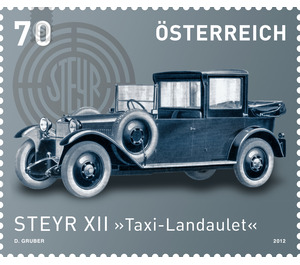automobile - Austria / II. Republic of Austria 2012 - 70 Euro Cent
Theme: Traffic, Transportation & Mobility
| Country | Austria / II. Republic of Austria |
| Issue Date | 2012 |
| Face Value | 70.00 |
| Edition Issued | 400,000 |
| Printing Type | offset |
| Stamp Type | Definitive |
| Item Type | Stamp |
| Chronological Issue Number | 2320 |
| Chronological Chapter | OOS-OE2 |
| SID | 787960 |
| In 59 Wishlists | |
The Steyr XII is undoubtedly one of the classics of the historic Austrian automobile industry; With the present special stamp, the antique car now finds its corresponding philatelic appreciation and the brand series "Cars" thus its attractive continuation. History: After the First World War, the Austrian factory in Steyr, which was founded in 1864 as a weapons factory by Josef and Franz Werndl and now belongs to the Magna Group, was banned by the Treaty of Versaille weapons production. In order to save the factory, the company relocated to automobile production. The conversion to civilian products succeeded, as early as 1920 rolled the first Steyr car from the factory. The construction period of the Steyr XII was characterized by the general spirit of optimism of the twenties. Money was earned and money was spent, cars sold well, production figures increased almost by themselves. Premiere finally had the eagerly awaited new car in London in October 1925, where Austria (Steyr and Austro Daimler) returned for the first time since 1918 was represented. At the time of his presentation, the generously cut car caught the attention of the audience, and the press was full of praise and admiration. The "12 Steyr" engineered by Anton Honsig was technically absolutely up to date: The low-noise 6-cylinder engine had a modest displacement of just 1.6 liters for economic reasons, but did with the chain-driven overhead camshaft and the smooth-running roller bearings still 30 hp at 3,000 rpm. The elaborate rear axle suspension with fixed differential and free-swinging axle halves (also called "swing axles") resulted in a high level of comfort and together with the lightweight low-frame chassis to a very good road holding.No fewer than 11,124 pieces were built between 1926 and 1929 - not Last but not least because of the successful export, among other things through its own sales company in Germany.The beautiful model that adorns the brand motif is a so-called "Landaulet." This refers to the bodywork of an automobile, in which the rear part of the roof through The word "Landaulet" is derived from "Landauer", a carriage that can be both closed and open.


